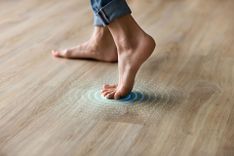Energy harvesting from Smart floors - welcome to the future


“What if we used the energy that’s going to waste all around us, all the time?” The above statement probably best sums up the simple premise behind energy harvesting technology. In recent years, scientists have taken this simple idea and run with it like nobody’s business.
In some of our previous posts, we’ve already taken a look at some of the weirdest and wackiest energy harvesting solutions out there. In this post, we’ll keep up our little tradition of welcoming the latest trends in the world of energy harvesting.
So, what’s it about this time then?
A team of Swiss researchers have come up with a way to harvest energy from the floor of your house.
But before we get into the how, what, why and when, we need to get clued in on some basics -
What’s piezo energy?
This technology that we’re going to look at is based on a phenomenon called the piezoelectric effect.
So, what’s the piezoelectric effect you ask?
Certain materials (like quartz, topaz or dry bone, for example) exhibit a property called piezoelectricity which allows them to generate a voltage when they are subjected to compression - i.e mechanical stress. In very simple terms, this happens because the positive and negative charges in the material get separated and move to opposite surfaces, giving rise to a voltage when they are connected with one another.
Piezoelectric energy harvesting is unquestionably one of the more well-known modalities of energy harvesting. The quite popular concept of harvesting energy from the footfalls on pavements or roads is based on the piezoelectric effect.
This principle has already been implemented successfully in quite a few instances - notably, Pavegen’s pavement tiles which generate clean electricity from the footsteps of people walking on them. The idea that the Swiss researchers had was very simple - if you say do the flooring of your house with these materials, you can potentially harvest energy from the force of people walking on them. They figured that this could open up some interesting possibilities. Especially, if the material in question was good old wood.
Technologies like these are crucial to make the dream of an environmentally sustainable future a reality. Among pavegen’s credentials is this futuristic football pitch where the floodlights are powered by the impact of the players’ footsteps.
So, now that we’ve got a fair idea of how the piezoelectric effect works, we can get into the cool piece of tech that those brainy Swiss scientists have come up with.
Spongy wooden nanogenerators
The project in question was the brainchild of a team of researchers from ETH Zurich and EMPA. The initial idea was very simple - it was to investigate the potential use of wood as a piezoelectric material. Headed by Ingo Burgert, the study was intended to find out if wood could be used as something more than just a building material. The team already has a track record of working with wood and conferring it some interesting characteristics, such that it could be used for entirely novel applications. They have already developed wood that is high-strength, water-repellant and magnetisable.
This time around, they joined hands with the Empa research group for their latest wood-based study. What with wood being universally available and relatively cheap, the team wanted to figure out if there was any way they could make a reliable piezoelectric energy harvester out of wood.
“Why hasn’t anybody else thought of this before?”, you might find yourself asking - that’s because wood is normally not considered to be a prime choice material for piezoelectric energy harvesting, because of its relative lack of flexibility.
However, the team came upon the idea that they could artificially confer some extra give, making the wood a more desirable energy harvesting candidate.
To this end, they employed a process called “delignification” where they subjected the wood to a process which rid the wood of natural substances called “lignins”. Lignins are loose, glue-like substances that naturally occur in wood. Their role is to act as a supporting structure and to keep the wood and bark of plants rigid and strong. Clearing some of these lignins out from the wood made it much more spongy and pliable.
“Lignins are what a tree uses, primarily to grow to incredible heights. This would be utterly impossible without lignin acting as a stabilising substance that connects cells and prevents them from giving in and just buckling” explains Burgert from the research team.
Now that the wood was more spongy, they were able to get it to return to its original shape after the pressure that was applied to it was removed. This made the wood a much more effective piezoelectric material to be used for electricity generation.
How did they go about doing this?
In the first iteration, the scientists soaked the wood in a bath of acetic acid, the chemical found in vinegar, and hydrogen peroxide, a common bleaching agent. When they tried the experiment a second time around, they opted for a more gentle approach - of using a fungus called Ganoderma applanatum, which uses biological mechanisms to cause the lignins in the wood to rot. The fungus was noted, in particular, for how gently it went about breaking down the lignin and hemicellulose in the wood. Moreover, this process could also be tightly controlled within laboratory settings.
The scientists now pitted both these iterations against each other and measured the amount of electricity that was produced by both. In the lab testing phase, the first round involved using a cube made of the material, measuring around 0.6 inches, using acetic acid. They were able to generate an output of about 0.63 V using this setup. What can be done with that kind of power you ask? well, that’s enough to power a small sensor, in a smart wearable for instance.
The variant which used the fungus put out even better numbers - In this case, a similar setup accounted for about 0.87 V. Another factor that makes this option more viable, the team claims, is that it is much more eco-friendly.
“We take advantage of the hierarchical structure of wood without first dissolving it, as is the case in paper production, for example, and then having to reconnect the fibers”, quips Burgert.
“The sponge we get consists of thin layers of cellulose that are superimposed on one another and can easily be squeezed together and then expand back – i.e wood has become elastic.”
The team subjected the cubes that they obtained through about 600 load cycles. What really stood out for the researchers was that the material displayed remarkable stability. Especially considering that the output was a more than respectable 0.63 to 0.87 V, the stability meant that this experiment could feasibly translate into real-world applications very soon.
The team were able to show, for example, that when they hooked up 30 of these wooden blocks together, in parallel, they were able to power a basic LCD display. If that doesn’t blow your mind, it really should. This essentially means that we can power electronics from the force of people walking on the floor.
This would have been unimaginable even just a few years ago.
Smart floors - welcome to the future
The process of taking these findings from the laboratory into the market place is going to take some time and doing. However, make no mistake - this is a truly promising study that highlights just how much of a massive role energy harvesting technologies are starting to play in the world around us.
Even as we speak, consumer electronics of newer and newer varieties are flooding the market, covering an ever-expanding range of functionalities - far from just health trackers and smartwatches, today we have a massively wide range of IoT devices that are built to serve myriad purposes.
As we’ve highlighted in several of our previous posts, this IoT wearable boom can’t continue to depend on batteries - at least, not in a way that’s sustainable and takes into account mankind’s ever mounting ecological impact.
It is no wonder then that energy harvesting technologies such as RF energy harvesting, triboelectric energy harvesting and piezoelectric energy harvesting are starting to find more and more usage in low-power and ultra-low-power IoT devices. Self-powered sensors that make use of these technologies are starting to look like a much better proposition to manufacturers, who are increasingly opting for them in place of battery-based solutions.
We might not know just yet what the future holds for energy harvesting technologies - but they sure don’t look like they’re disappearing anytime soon.













